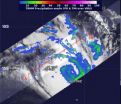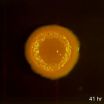(Press-News.org) The largest mass extinction in the history of animal life occurred some 252 million years ago, wiping out more than 96 percent of marine species and 70 percent of life on land — including the largest insects known to have inhabited the Earth. Multiple theories have aimed to explain the cause of what's now known as the end-Permian extinction, including an asteroid impact, massive volcanic eruptions, or a cataclysmic cascade of environmental events. But pinpointing the cause of the extinction requires better measurements of how long the extinction period lasted.
Now researchers at MIT have determined that the end-Permian extinction occurred over 60,000 years, give or take 48,000 years — practically instantaneous, from a geologic perspective. The new timescale is based on more precise dating techniques, and indicates that the most severe extinction in history may have happened more than 10 times faster than scientists had previously thought.
"We've got the extinction nailed in absolute time and duration," says Sam Bowring, the Robert R. Shrock Professor of Earth and Planetary Sciences at MIT. "How do you kill 96 percent of everything that lived in the oceans in tens of thousands of years? It could be that an exceptional extinction requires an exceptional explanation."
In addition to establishing the extinction's duration, Bowring, graduate student Seth Burgess, and a colleague from the Nanjing Institute of Geology and Paleontology also found that, 10,000 years before the die-off, the oceans experienced a pulse of light carbon, which likely reflects a massive addition of carbon dioxide to the atmosphere. This dramatic change may have led to widespread ocean acidification and increased sea temperatures by 10 degrees Celsius or more, killing the majority of sea life.
But what originally triggered the spike in carbon dioxide? The leading theory among geologists and paleontologists has to do with widespread, long-lasting volcanic eruptions from the Siberian Traps, a region of Russia whose steplike hills are a result of repeated eruptions of magma. To determine whether eruptions from the Siberian Traps triggered a massive increase in oceanic carbon dioxide, Burgess and Bowring are using similar dating techniques to establish a timescale for the Permian period's volcanic eruptions that are estimated to have covered over five million cubic kilometers.
"It is clear that whatever triggered extinction must have acted very quickly," says Burgess, the lead author of a paper that reports the results in this week's Proceedings of the National Academy of Sciences, "fast enough to destabilize the biosphere before the majority of plant and animal life had time to adapt in an effort to survive."
Pinning dates on an extinction
In 2006, Bowring and his students made a trip to Meishan, China, a region whose rock formations bear evidence of the end-Permian extinction; geochronologists and paleontologists have flocked to the area to look for clues in its layers of sedimentary rock. In particular, scientists have focused on a section of rock that is thought to delineate the end of the Permian, and the beginning of the Triassic, based on evidence such as the number of fossils found in surrounding rock layers.
Bowring sampled rocks from this area, as well as from nearby alternating layers of volcanic ash beds and fossil-bearing rocks. After analyzing the rocks in the lab, his team reported in 2011 that the end-Permian likely lasted less than 200,000 years. However, this timeframe still wasn't precise enough to draw any conclusions about what caused the extinction.
Now, the team has revised its estimates using more accurate dating techniques based on a better understanding of uncertainties in timescale measurements.
With this knowledge, Bowring and his colleagues reanalyzed rock samples collected from five volcanic ash beds at the Permian-Triassic boundary. The researchers pulverized rocks and separated out tiny zircon crystals containing a mix of uranium and lead. They then isolated uranium from lead, and measured the ratios of both isotopes to determine the age of each rock sample.
From their measurements, the researchers determined a much more precise "age model" for the end-Permian extinction, which now appears to have lasted about 60,000 years — with an uncertainty of 48,000 years — and was immediately preceded by a sharp increase in carbon dioxide in the oceans.
'Spiraling toward the truth'
The new timeline adds weight to the theory that the extinction was triggered by massive volcanic eruptions from the Siberian Traps that released volatile chemicals, including carbon dioxide, into the atmosphere and oceans. With such a short extinction timeline, Bowring says it is possible that a single, catastrophic pulse of magmatic activity triggered an almost instantaneous collapse of all global ecosystems.
To confirm whether the Siberian Traps are indeed the extinction's smoking gun, Burgess and Bowring plan to determine an equally precise timeline for the Siberian Traps eruptions, and will compare it to the new extinction timeline to see where the two events overlap. The researchers will investigate additional areas in China to see if the duration of the extinction can be even more precisely determined.
"We've refined our approach, and now we have higher accuracy and precision," Bowring says. "You can think of it as slowly spiraling in toward the truth."
INFORMATION:
Giant mass extinction may have been quicker than previously thought
MIT researchers find that the end-Permian extinction happened in 60,000 years -- much faster than earlier estimates
2014-02-11
ELSE PRESS RELEASES FROM THIS DATE:
High pollutant levels in Guánica Bay 'represent serious toxic threat' to corals
2014-02-11
The pollutants measured in the sediments of Guánica Bay, Puerto Rico, in a new NOAA study were among the highest concentrations of PCBs, chlordane, chromium and nickel ever measured in the history of NOAA's National Status & Trends, a nationwide contaminant monitoring program that began in 1986.
Researchers from the National Ocean Service's National Centers for Coastal Ocean Science (NCCOS) studied the reef's ecology to help establish baseline conditions that coastal managers can use to measure changes resulting from new efforts to manage pollution. Among the items studied ...
Design prototype chip makes possible a fully implantable cochlear implant
2014-02-11
BOSTON (Feb. 10, 2014) — Researchers from Massachusetts Eye and Ear, Harvard Medical School, and Massachusetts Institute of Technology (MIT) have designed a prototype system-on-chip (SoC) that could make possible a fully implanted cochlear implant. They will present their findings on Feb. 11at the IEEE International Solid State Circuits Conference in San Francisco.
A cochlear implant is a device that electronically stimulates the auditory nerve to restore hearing in people with profound hearing loss. Conventional cochlear implants are made up of an external unit with ...
NASA's TRMM satellite eyes rainfall in Tropical Cyclone Fobane
2014-02-11
Some towering thunderstorms were spotted in Tropical Cyclone Fobane as NASA's TRMM satellite passed over the Southern Indian Ocean on February 10. Fobane was formerly Tropical Cyclone 14S and when it strengthened into a tropical storm it was renamed.
NASA and the Japan Aerospace Exploration Agency manages the Tropical Rainfall Measuring Mission satellite known as TRMM. TRMM has the capability to measure rainfall rates from space and data that can be used to determine the heights of thunderstorms that make up a storm. When TRMM passed over Tropical Cyclone Fobane on February ...
Cars, computers, TVs spark obesity in developing countries
2014-02-11
The spread of obesity and type-2 diabetes could become epidemic in low-income countries, as more individuals are able to own higher priced items such as TVs, computers and cars. The findings of an international study, led by Simon Fraser University health sciences professor Scott Lear, are published today in the Canadian Medical Association Journal.
Lear headed an international research team that analyzed data on more than 150,000 adults from 17 countries, ranging from high and middle income to low-income nations.
Researchers, who questioned participants about ownership ...
Recycling of 'chauffeur protein' helps regulate fat production
2014-02-11
Studying a cycle of protein interactions needed to make fat, Johns Hopkins researchers say they have discovered a biological switch that regulates a protein that causes fatty liver disease in mice. Their findings, they report, may help develop drugs to decrease excessive fat production and its associated conditions in people, including fatty liver disease and diabetes.
A summary of the research appeared online on Jan. 29 in the Journal of Biological Chemistry.
"We've learned how the body finely tunes levels of a protein called SCAP that is required to turn on fat production ...
Long distance signals protect brain from viral infections
2014-02-11
The brain contains a defense system that prevents at least two unrelated viruses—and possibly many more—from invading the brain at large. The research is published online ahead of print in the Journal of Virology.
"Our work points to the remarkable ability of the immune system, even within the brain, to protect us against opportunistic viruses," says Anthony van den Pol of Yale University, an author on the study.
The research explains a long-standing mystery. The olfactory mucosa in the nose can serve as a conduit for a number of viruses to enter the brain including ...
Mayo Clinic identifies a key cellular pathway in prostate cancer
2014-02-11
ROCHESTER, Minn. — Mayo Clinic researchers have shed light on a new mechanism by which prostate cancer develops in men. Central to development of nearly all prostate cancer cases are malfunctions in the androgen receptor — the cellular component that binds to male hormones. The research team has shown that SPOP, a protein that is most frequently mutated in human prostate cancers, is a key regulator of androgen receptor activity that prevents uncontrolled growth of cells in the prostate and thus helps prevent cancer. The findings appear in the journal Cell Reports.
"By ...
Flowing water on Mars appears likely but hard to prove
2014-02-11
Martian experts have known since 2011 that mysterious, possibly water-related streaks appear and disappear on the planet's surface. Georgia Institute of Technology Ph.D. candidate Lujendra Ojha discovered them while an undergraduate at the University of Arizona. These features were given the descriptive name of recurring slope lineae (RSL) because of their shape, annual reappearance and occurrence generally on steep slopes such as crater walls. Ojha has been taking a closer look at this phenomenon, searching for minerals that RSL might leave in their wake, to try to understand ...
With their amazing necks, ants don't need 'high hopes' to do heavy lifting
2014-02-11
COLUMBUS, Ohio—High hopes may help move a rubber tree plant (as the old song goes), but the real secret to the ant's legendary strength may lie in its tiny neck joint.
In the Journal of Biomechanics, researchers report that the neck joint of a common American field ant can withstand pressures up to 5,000 times the ant's weight.
"Ants are impressive mechanical systems—astounding, really," said Carlos Castro, assistant professor of mechanical and aerospace engineering at The Ohio State University. "Before we started, we made a somewhat conservative estimate that they ...
Chips that listen to bacteria
2014-02-11
VIDEO:
The development of colony biofilms by Pseudomonas aeruginosa is affected by redox-active compounds called phenazines. A phenazine-null mutant forms a hyperwrinkled colony with prominent spokes, while wild-type colonies are more...
Click here for more information.
New York, NY—February 10, 2014—In a study published today in Nature Communications, a research team led by Ken Shepard, professor of electrical engineering and biomedical engineering at Columbia Engineering, ...
LAST 30 PRESS RELEASES:
Neuroscientists devise formulas to measure multilingualism
New prostate cancer trial seeks to reduce toxicity without sacrificing efficacy
Geometry shapes life
A CRISPR screen reveals many previously unrecognized genes required for brain development and a new neurodevelopmental disorder
Hot flush treatment has anti-breast cancer activity, study finds
Securing AI systems against growing cybersecurity threats
Longest observation of an active solar region
Why nail-biting, procrastination and other self-sabotaging behaviors are rooted in survival instincts
Regional variations in mechanical properties of porcine leptomeninges
Artificial empathy in therapy and healthcare: advancements in interpersonal interaction technologies
Why some brains switch gears more efficiently than others
UVA’s Jundong Li wins ICDM’S 2025 Tao Li Award for data mining, machine learning
UVA’s low-power, high-performance computer power player Mircea Stan earns National Academy of Inventors fellowship
Not playing by the rules: USU researcher explores filamentous algae dynamics in rivers
Do our body clocks influence our risk of dementia?
Anthropologists offer new evidence of bipedalism in long-debated fossil discovery
Safer receipt paper from wood
Dosage-sensitive genes suggest no whole-genome duplications in ancestral angiosperm
First ancient human herpesvirus genomes document their deep history with humans
Why Some Bacteria Survive Antibiotics and How to Stop Them - New study reveals that bacteria can survive antibiotic treatment through two fundamentally different “shutdown modes”
UCLA study links scar healing to dangerous placenta condition
CHANGE-seq-BE finds off-target changes in the genome from base editors
The Journal of Nuclear Medicine Ahead-of-Print Tip Sheet: January 2, 2026
Delayed or absent first dose of measles, mumps, and rubella vaccination
Trends in US preterm birth rates by household income and race and ethnicity
Study identifies potential biomarker linked to progression and brain inflammation in multiple sclerosis
Many mothers in Norway do not show up for postnatal check-ups
Researchers want to find out why quick clay is so unstable
Superradiant spins show teamwork at the quantum scale
Cleveland Clinic Research links tumor bacteria to immunotherapy resistance in head and neck cancer
[Press-News.org] Giant mass extinction may have been quicker than previously thoughtMIT researchers find that the end-Permian extinction happened in 60,000 years -- much faster than earlier estimates




